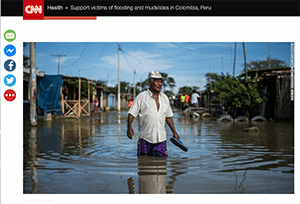
Flooding in parts of South America has impacted some of the flower growing regions, although to what extent is unclear.
Adverse weather in Colombia and Ecuador in March affected production for some growers — leaving industry members hopeful that sunny conditions in recent days will help keep production on track for the busy spring season, including Mother’s Day.
Colombia battled through cold weather and heavy rainfall last month, according to Oscar Fernandez, director of sales at Equiflor. (Indeed, flooding in the country has led to more than 250 deaths and hundreds of missing and injured people.) Meanwhile, in Ecuador “it has been unseasonably cold with only a few hours of sunlight causing production to be extremely low,” Fernandez explained.
“All production is affected in some way,” he said. “Carnations going to sleep and roses can develop a stem with no flower, and that is due to cold weather and lack of luminosity,” he explained, estimating that overall production is currently down by about 30 percent.
“Production should start to increase over the next week, which is great, as we approach wedding, graduation and prom season and, of course, head in to Mother’s Day,” Fernandez said.
In Chicago, Elena Diaz, a farm liaison in Colombia for Kennicott Brothers Company, said growers are estimating rose production is currently 25 percent to 30 percent lower than usual, but that could change quickly.
“Normally by this week , production in roses starts increasing, but this year it is late, the pick has moved between one and two weeks, which … will be right on time for Mother’s Day,” Diaz said, noting that Botrytis and mildew have caused headaches for some rose growers.
Diaz also said mini-carnation production is off by about 20 percent, with hot pink varieties most affected, and standard carnations are off by about 15 percent to 20 percent. With pompons, “it is really early to know,” she said. “Farms are saying since the cycle is shorter they are not as affected as other crops, but they are saying their production is in general around 10 percent lower than expected.”
Eliana Alzate, a spokeswoman for Asocolflores, noted “it’s difficult to predict if production has affected or not until the time of product shipping.” She said that none of the group’s member farms suffered structural damage or loss of life from the flooding. (Mocoa, the town suffering the worst during the floods, is located in Putumayo province, bordering Ecuador and Peru; most flower farms are situated in the central part of the country.) She also said it’s important to keep the news in perspective.
“The mix between rain and sun, and the Colombian land conditions, are the reasons we have an excellent reputation of diversity and quality products,” she said. “We are ready for Mother’s Day, and the Colombian flowers companies are working to supply the demand of flowers as usual.”



